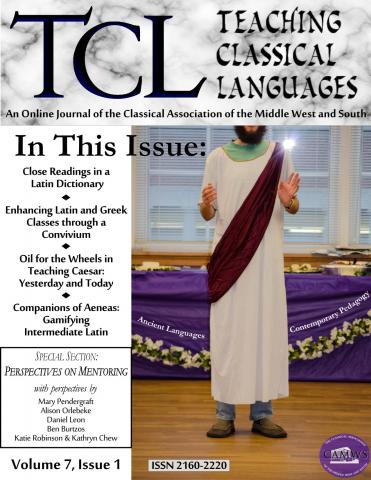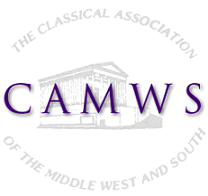Welcome to Teaching Classical Languages (TCL). TCL is the peer-reviewed, online journal dedicated to exploring how we teach (and how we learn) Greek and Latin. TCL is sponsored by the Classical Association of the Middle West and South (CAMWS).
Fall 2015

Abstracts of Articles
Close Readings in a Latin Dictionary
This article presents an assignment designed to stir students’ curiosity about the relations between literary language and Roman society, and the powers of translation to clarify or obscure those relations. Though designed for a fourth-semester university Latin course, this assignment is equally appropriate for advanced high school students. Students are asked to choose a cluster of closely related words (e.g. liber, libertas, liberalis, and liberalitas) and to explore in depth what the entries offered by their own intermediate or pocket dictionaries do and––crucially––do not communicate about the uses of these words in Roman life and literature. The exercise heightens sensitivity to the ways meaning may be shaped in specific settings, both at the micro-level of word order and in relation to broader socio-economic and political contexts. It also helps students grasp their own role as translators in generating meanings. This work can therefore simultaneously sharpen awareness of a much larger cultural realm beyond students’ fragmentary experiences with Roman literature, and improve their technical skills in reading and translating Latin.
Enhancing Latin and Greek Classes through a Convivium
Inspired by an elementary Spanish class, the author has instituted an annual banquet in her department for students enrolled in elementary and intermediate Latin and Greek classes. The banquet not only provides an opportunity for students to sample food based on the recipes of Apicius, Cato, Athenaeus, and Archestratus, but it also allows for additional language acquisition. Students translate a formal invitation which is issued in Latin or Greek, compose a response to the invitation in Latin or Greek, and compete in contests focusing on translation, original composition, and dramatic recitation. Students also compete together with their classmates against other classes in a classics-inspired scavenger hunt as part of the event. The banquet has promoted the development of learning communities among students taking classical languages, introduced students in language classes to Roman and Greek culture and thus generated interest in classics as a field, allowed for a more interdisciplinary approach to language education, and energized the elementary and intermediate language programs.
Oil for the Wheels in Teaching Caesar: Yesterday and Today
This article examines some ways of enlivening Caesar’s De bello Gallico in the classroom. It begins by considering the pedagogical methods of Mary E. Harwood, a Latin teacher in the early 1900s. Since Ms. Harwood’s students often found Caesar to be a boring, irrelevant text, she developed some creative teaching methods to lessen her own sense of frustration and to help her students better understand, visualize, and appreciate the text. The author argues that even though some of Ms. Harwood’s early twentieth-century strategies would not necessarily work in twenty-first-century Advanced Placement classrooms, her general philosophy of teaching Caesar is still quite germane. In addition to considering Ms. Harwood’s suggestions for teaching Caesar, the article also offers some examples of how the author approaches the challenges of teaching Caesar in his own AP class, in particular by drawing upon popular culture and current events.
Companions of Aeneas: Gamifying Intermediate Latin
In order to increase Roman cultural content in an intermediate Latin course on Vergil’s Aeneid at Earlham College, the author introduced elements of role-playing games into an otherwise traditional translation class. Students developed individual characters whose details were informed by weekly research projects on different aspects of Roman culture. An additive grading system was also incorporated to enable students and their characters to track progress in terms of “leveling up.” This paper explains the implementation and mechanics of this gamification and concludes that the addition of some gamified courses into classical curricula would prove beneficial; the strengths of gamification (increased cultural content and student motivation) compare favorably to its weaknesses (decreased language content, increased preparation time), especially in departments that have limited course offerings.

